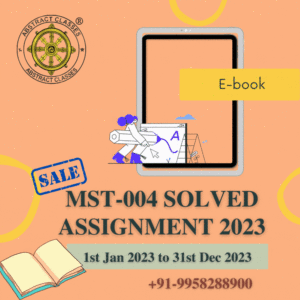
IGNOU BCHCT-133 Solved Assignment 2024 | B.Sc. CBCS Chemistry
₹49.00
Please read the following points before ordering this IGNOU Assignment Solution.
Share with your Friends
IGNOU BCHCT-133 Assignment Question Paper 2024
bchct-133-solved-assignment-2024-85751874-409c-4a3e-a24f-05d2d11f08b6
- a) Define and explain a thermodynamically reversible process.
- a) Define standard enthalpy of formation and describe a method for its direct determination with the help of an example.
- a) Give the statements of Zeroth, First, Second and the Third laws of thermodynamics and outline their significance.
- a) In the following equilibrium, predict the direction of shift of equilibrium for each condition listed below:
ii) increased pressure
iii) lowering of temperature.
- a) Explain the effect of common ions on the ionisation equilibria of weak acids with the help of a suitable example.
- a) Explain why Nitro group is meta-directing deactivator?
- a) In normal reaction conditions, chlorobenzene does not react with
NaOH \mathrm{NaOH} NaOH \mathrm{NaOH}
- a) How will you perform following conversions?
i) Phenol top p
ii) 1,3-dihydroxyphenol to 1-(2,4-dihydroxyphenyl)ethanal
- a) Arrange the following carbonyl compounds in the order of their favourability for formation of nitriles:
BCHCT-133 Sample Solution 2024
bchct-133-solved-assignment-2024-ss-10cd7422-4b11-4531-9171-a6445826d855
- a) Define and explain a thermodynamically reversible process.
-
Infinitesimal Driving Forces: The difference in driving forces (such as pressure, temperature, or chemical potential) between the system and surroundings is infinitesimal, so the process occurs at an infinitesimally slow rate. This ensures that the system can be reversed at any point without a finite change in the external conditions.
-
No Entropy Production: During a reversible process, there is no increase in entropy within the system and its surroundings. This means there is no dissipation of energy as heat due to friction, viscosity, or other non-conservative forces, and all heat transfer is perfectly efficient.
-
Efficiency: Reversible processes define the upper limit of efficiency for engines and other thermodynamic cycles. For example, the Carnot cycle, which is a theoretical reversible cycle, defines the maximum possible efficiency that any heat engine operating between two temperatures can achieve.
-
Equilibrium State Changes: In reversible processes, the system’s changes in state (such as volume, pressure, and temperature) can be described exactly by the equations of state since the system is always at equilibrium.
-
Work and Heat: For a reversible process, the work done by the system on the surroundings is maximized, and the work done on the system is minimized. Similarly, reversible heat transfer is the most efficient.
W W n n R R T T V_(f) V_f V_(i) V_i
n=0.25 n = 0.25 R=8.314″J/mol”*”K” R = 8.314 \, \text{J/mol}\cdot\text{K} T=27^(@)”C”=27+273.15=300.15″K” T = 27^\circ\text{C} = 27 + 273.15 = 300.15 \, \text{K} V_(i)=2.0″dm”^(3)=2.0 xx10^(-3)”m”^(3) V_i = 2.0 \, \text{dm}^3 = 2.0 \times 10^{-3} \, \text{m}^3 1″dm”^(3)=10^(-3)”m”^(3) 1 \, \text{dm}^3 = 10^{-3} \, \text{m}^3 V_(f)=10″dm”^(3)=10 xx10^(-3)”m”^(3) V_f = 10 \, \text{dm}^3 = 10 \times 10^{-3} \, \text{m}^3
- a) Define standard enthalpy of formation and describe a method for its direct determination with the help of an example.
Direct Determination of Standard Enthalpy of Formation
-
Preparation of Reactants: The elements in their standard states are prepared. For example, if we are determining the standard enthalpy of formation of water (H₂O), we would prepare hydrogen gas (H₂) and oxygen gas (O₂).
-
Reaction in a Calorimeter: The reactants are combined in a calorimeter, a device used to measure the heat of chemical reactions. The reaction is initiated under controlled conditions.
-
Measurement of Temperature Change: The calorimeter measures the temperature change of the surroundings (usually a water bath) due to the reaction.
-
Calculation of Heat Change: Using the temperature change and the specific heat capacity of the surroundings, the heat change (q) associated with the reaction is calculated.
-
Determination of Enthalpy Change: The heat change is then used to calculate the enthalpy change for the reaction. If the reaction produces one mole of the compound, this enthalpy change is the standard enthalpy of formation. If not, it must be adjusted to reflect the formation of one mole of the compound.
Example: Formation of Water
Frequently Asked Questions (FAQs)
You can access the Complete Solution through our app, which can be downloaded using this link:
Simply click “Install” to download and install the app, and then follow the instructions to purchase the required assignment solution. Currently, the app is only available for Android devices. We are working on making the app available for iOS in the future, but it is not currently available for iOS devices.
Yes, It is Complete Solution, a comprehensive solution to the assignments for IGNOU. Valid from January 1, 2023 to December 31, 2023.
Yes, the Complete Solution is aligned with the IGNOU requirements and has been solved accordingly.
Yes, the Complete Solution is guaranteed to be error-free.The solutions are thoroughly researched and verified by subject matter experts to ensure their accuracy.
As of now, you have access to the Complete Solution for a period of 6 months after the date of purchase, which is sufficient to complete the assignment. However, we can extend the access period upon request. You can access the solution anytime through our app.
The app provides complete solutions for all assignment questions. If you still need help, you can contact the support team for assistance at Whatsapp +91-9958288900
No, access to the educational materials is limited to one device only, where you have first logged in. Logging in on multiple devices is not allowed and may result in the revocation of access to the educational materials.
Payments can be made through various secure online payment methods available in the app.Your payment information is protected with industry-standard security measures to ensure its confidentiality and safety. You will receive a receipt for your payment through email or within the app, depending on your preference.
The instructions for formatting your assignments are detailed in the Assignment Booklet, which includes details on paper size, margins, precision, and submission requirements. It is important to strictly follow these instructions to facilitate evaluation and avoid delays.
Terms and Conditions
- The educational materials provided in the app are the sole property of the app owner and are protected by copyright laws.
- Reproduction, distribution, or sale of the educational materials without prior written consent from the app owner is strictly prohibited and may result in legal consequences.
- Any attempt to modify, alter, or use the educational materials for commercial purposes is strictly prohibited.
- The app owner reserves the right to revoke access to the educational materials at any time without notice for any violation of these terms and conditions.
- The app owner is not responsible for any damages or losses resulting from the use of the educational materials.
- The app owner reserves the right to modify these terms and conditions at any time without notice.
- By accessing and using the app, you agree to abide by these terms and conditions.
- Access to the educational materials is limited to one device only. Logging in to the app on multiple devices is not allowed and may result in the revocation of access to the educational materials.
Our educational materials are solely available on our website and application only. Users and students can report the dealing or selling of the copied version of our educational materials by any third party at our email address (abstract4math@gmail.com) or mobile no. (+91-9958288900).
In return, such users/students can expect free our educational materials/assignments and other benefits as a bonafide gesture which will be completely dependent upon our discretion.
Related products
-
IGNOU Assignment Solution
IGNOU MEG-15 Solved Assignment 2022-2023 | MEG | Comparative Literature: Theory and Practice
₹101.00 Go to the App -
IGNOU Assignment Solution
IGNOU MEG-09 Solved Assignment 2022-2023 | MEG | Australian Literature
₹101.00 Go to the App -
IGNOU Assignment Solution
IGNOU MEG-01 Solved Assignment 2022-2023 | MEG | British Poetry
₹101.00 Go to the App




